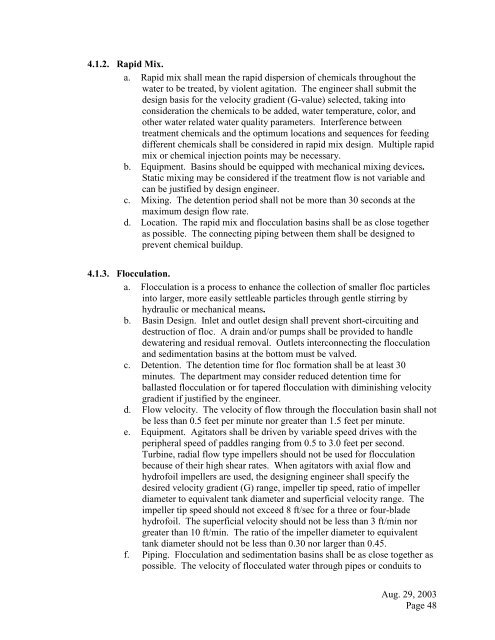Design Guide for Community Water Systems - The Water, Sanitation ...
Design Guide for Community Water Systems - The Water, Sanitation ...
Design Guide for Community Water Systems - The Water, Sanitation ...
Create successful ePaper yourself
Turn your PDF publications into a flip-book with our unique Google optimized e-Paper software.
4.1.2. Rapid Mix.a. Rapid mix shall mean the rapid dispersion of chemicals throughout thewater to be treated, by violent agitation. <strong>The</strong> engineer shall submit thedesign basis <strong>for</strong> the velocity gradient (G-value) selected, taking intoconsideration the chemicals to be added, water temperature, color, andother water related water quality parameters. Interference betweentreatment chemicals and the optimum locations and sequences <strong>for</strong> feedingdifferent chemicals shall be considered in rapid mix design. Multiple rapidmix or chemical injection points may be necessary.b. Equipment. Basins should be equipped with mechanical mixing devices.Static mixing may be considered if the treatment flow is not variable andcan be justified by design engineer.c. Mixing. <strong>The</strong> detention period shall not be more than 30 seconds at themaximum design flow rate.d. Location. <strong>The</strong> rapid mix and flocculation basins shall be as close togetheras possible. <strong>The</strong> connecting piping between them shall be designed toprevent chemical buildup.4.1.3. Flocculation.a. Flocculation is a process to enhance the collection of smaller floc particlesinto larger, more easily settleable particles through gentle stirring byhydraulic or mechanical means.b. Basin <strong>Design</strong>. Inlet and outlet design shall prevent short-circuiting anddestruction of floc. A drain and/or pumps shall be provided to handledewatering and residual removal. Outlets interconnecting the flocculationand sedimentation basins at the bottom must be valved.c. Detention. <strong>The</strong> detention time <strong>for</strong> floc <strong>for</strong>mation shall be at least 30minutes. <strong>The</strong> department may consider reduced detention time <strong>for</strong>ballasted flocculation or <strong>for</strong> tapered flocculation with diminishing velocitygradient if justified by the engineer.d. Flow velocity. <strong>The</strong> velocity of flow through the flocculation basin shall notbe less than 0.5 feet per minute nor greater than 1.5 feet per minute.e. Equipment. Agitators shall be driven by variable speed drives with theperipheral speed of paddles ranging from 0.5 to 3.0 feet per second.Turbine, radial flow type impellers should not be used <strong>for</strong> flocculationbecause of their high shear rates. When agitators with axial flow andhydrofoil impellers are used, the designing engineer shall specify thedesired velocity gradient (G) range, impeller tip speed, ratio of impellerdiameter to equivalent tank diameter and superficial velocity range. <strong>The</strong>impeller tip speed should not exceed 8 ft/sec <strong>for</strong> a three or four-bladehydrofoil. <strong>The</strong> superficial velocity should not be less than 3 ft/min norgreater than 10 ft/min. <strong>The</strong> ratio of the impeller diameter to equivalenttank diameter should not be less than 0.30 nor larger than 0.45.f. Piping. Flocculation and sedimentation basins shall be as close together aspossible. <strong>The</strong> velocity of flocculated water through pipes or conduits toAug. 29, 2003Page 48
















